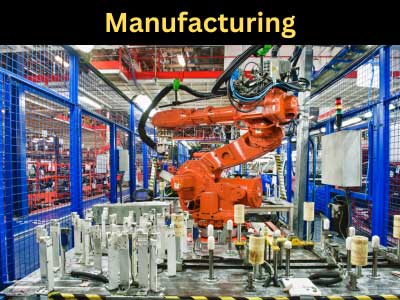Key Takeaway
Achieving manufacturing efficiency is challenging due to factors like cost management, labor shortages, and automation integration. Companies often struggle to balance production costs while maintaining high-quality output. Controlling inventory and accurately forecasting demand are also significant hurdles that impact efficiency.
Supply chain disruptions further complicate manufacturing processes, leading to delays and increased costs. Additionally, tracking and analyzing data effectively is essential but often difficult. Overcoming these challenges requires strategic planning, investment in technology, and continuous process improvement to ensure that manufacturing operations run smoothly and efficiently.
Equipment Downtime and Maintenance Issues
One of the most significant barriers to manufacturing efficiency is equipment downtime. When machines stop working unexpectedly or require frequent maintenance, it directly affects production timelines and output. Even a brief period of downtime can lead to costly delays, missed deadlines, and dissatisfied customers.
The root causes of downtime can vary, from mechanical failure to improper maintenance schedules. Many manufacturers still rely on reactive maintenance, fixing machines only when they break down. However, this approach is inefficient and often leads to prolonged downtime. To combat this, more companies are turning to predictive maintenance, which uses real-time data to forecast when machines need servicing.
Regular and proactive maintenance schedules, combined with the right technology, can minimize downtime and keep equipment running smoothly. For new engineers, learning to implement and manage these systems is key to maintaining production efficiency.

Supply Chain Disruptions and Material Shortages
A smooth supply chain is critical for maintaining steady production, but disruptions in the supply chain can cause significant setbacks. Material shortages, delays in deliveries, and supplier issues can all halt manufacturing operations. The unpredictability of global supply chains, particularly in times of crisis, adds to the complexity.
Supply chain disruptions can result from various factors, such as political instability, natural disasters, or even fluctuating market demands. When manufacturers do not have the materials they need on time, production schedules are delayed, leading to increased costs and a loss of productivity.
To mitigate these risks, manufacturers are increasingly adopting more sophisticated supply chain management strategies. Technologies such as real-time tracking and advanced forecasting tools can help manufacturers anticipate potential disruptions and adjust their plans accordingly. Having a diversified supplier base can also provide flexibility, ensuring that a single supplier issue doesn’t derail the entire production process.
Workforce Skill Gaps and Training Needs
Another critical challenge in achieving manufacturing efficiency is the skill gap among the workforce. As manufacturing becomes more automated and reliant on advanced technologies, the need for skilled workers who can manage and operate these systems is growing. However, many manufacturers are finding it difficult to fill these roles with adequately trained personnel.
A lack of skilled workers can lead to inefficiencies in the production process, including slow machine operation, improper handling of equipment, or an inability to troubleshoot problems when they arise. Additionally, as experienced workers retire, there is often a gap in knowledge transfer, leaving newer employees less equipped to handle the complexities of modern manufacturing.
To overcome this challenge, companies must invest in workforce development and continuous training programs. Upskilling existing employees and attracting new talent through educational partnerships with technical schools can help bridge the skills gap. It is also important to foster a culture of continuous learning within the organization to keep up with the evolving technological landscape.
Balancing Cost Efficiency with Product Quality
Cost efficiency is essential in manufacturing, but it must be balanced with maintaining high product quality. When manufacturers focus solely on cutting costs, it can sometimes lead to compromises in quality. This can result in higher defect rates, customer dissatisfaction, and increased returns or rework, all of which eat into profits.
Manufacturers face the challenge of finding the right balance between minimizing production costs and ensuring that products meet or exceed quality standards. Poor quality control can lead to significant long-term losses, even if initial production costs are reduced.
One way to maintain this balance is through implementing lean manufacturing principles. Lean manufacturing focuses on reducing waste and optimizing processes without compromising quality. By streamlining production and eliminating non-value-added activities, manufacturers can achieve cost efficiency while maintaining product integrity.
Quality control systems, such as real-time monitoring and automated inspections, can also help manufacturers ensure that every product meets the required standards, reducing defects and rework.
Implementing New Technologies and Automation
Incorporating new technologies and automation into manufacturing processes is essential for staying competitive, but it can also present significant challenges. While automation can greatly improve efficiency, the initial implementation often comes with high costs, disruptions to current workflows, and the need for specialized training.
Many manufacturers struggle with deciding when and how to implement new technologies. Automation tools like robotics, AI, and machine learning can optimize production, but the transition can be complex. The integration process may require a complete overhaul of existing systems, and any disruption can temporarily slow down production.
Moreover, resistance to change from employees can be a barrier to adopting new technologies. Workers may fear that automation will replace their jobs or feel overwhelmed by learning new systems. To successfully implement automation, manufacturers need a clear strategy that includes employee engagement, proper training, and phased implementation to ensure a smooth transition.
The key to overcoming these challenges is careful planning and ensuring that technology adoption aligns with the company’s long-term goals for productivity, quality, and workforce satisfaction.
Conclusion
Achieving manufacturing efficiency is a complex process that requires addressing various challenges, from minimizing equipment downtime to managing the supply chain, closing workforce skill gaps, and balancing costs with product quality. Each of these obstacles presents unique difficulties, but with the right strategies—such as predictive maintenance, advanced supply chain management, and workforce training—manufacturers can streamline operations and improve efficiency.
Implementing new technologies and automation is also crucial for staying competitive, though it requires careful planning and employee support. By tackling these challenges head-on, manufacturers can optimize their processes, reduce costs, and achieve long-term success in an increasingly competitive industry.
